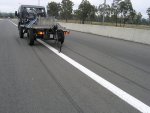We seem to be morphing a little from the original topic, but hey, I don't mind...
i believe other states may require different certification
Let me set the mood by saying that certification of vehicle modifications in Australia is total rubbish!
There is no denying that companies that can do Second Stage Manufacturing (SSM) definitely make life easier for the end user, as these modifications are Department of Infrastructure and Transport (DOTARS) approved. This means that it is a federal certification valid in all states. That is a really big plus if you move to a different state and can be a used as a selling point too.
Any modification that requires an engineer to certify it is "technically" only valid in the state in which it was certified. This is the problem that most of us have to deal with.
Given that some of the major modifications done to my truck were carried out by ATW in Queensland I was concerned about this because I live in the ACT where our motor registry is renowned for being one of the most painful.
The engineer who certified the work on my truck actually contacted the ACT motor registry to ensure that the engineering report met all their requirements. I also confirmed that this engineer was on the ACT's "approved engineers" list, which he was. This made the process of getting my truck registered in the ACT relatively straight forward, but it was only that way because I did all the groundwork first. The sad thing is that I needed to do this.
In my experience, motor vehicle inspectors regularly say no because they can; apparently it's easier that way. The worst thing is that they don't all play by the same rules; it depends on who you get on the day, which really sux!
I was fortunate that the inspector that I dealt with was excellent. I had been to the motor registry on days when he was not there and got totally stuffed around. I quickly learned that I should deal with him and him alone.
The point I am trying to make here is that if you plan on getting any modification work carried out in a state other than the one you live in, do your due diligence. This is extremely important if you intend to purchase a vehicle that has had modifications done in another state. If possible you should get copies of any engineering reports and have an inspector give their opinion of the modifications and confirm that they would be legal in your state. If you don't you could be up for the costs to get the vehicle re-engineered. I was also told that engineering reports were only valid for eight years (in the ACT at least); after that it was at the inspector's discretion.
Getting vehicle modifications done in Australia is a real can of worms. The biggest problem, as I see it, is that there are no definitive rules; they are all guidelines and therefore open to interpretation by the person reading them.
The challenge is to find someone that interprets the guidelines in a way that works for you...


